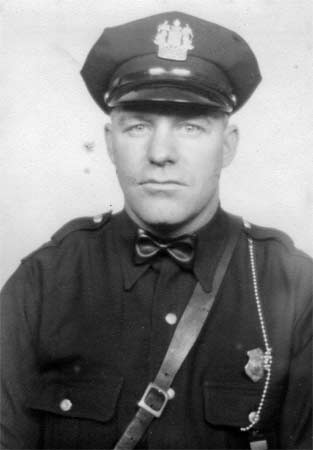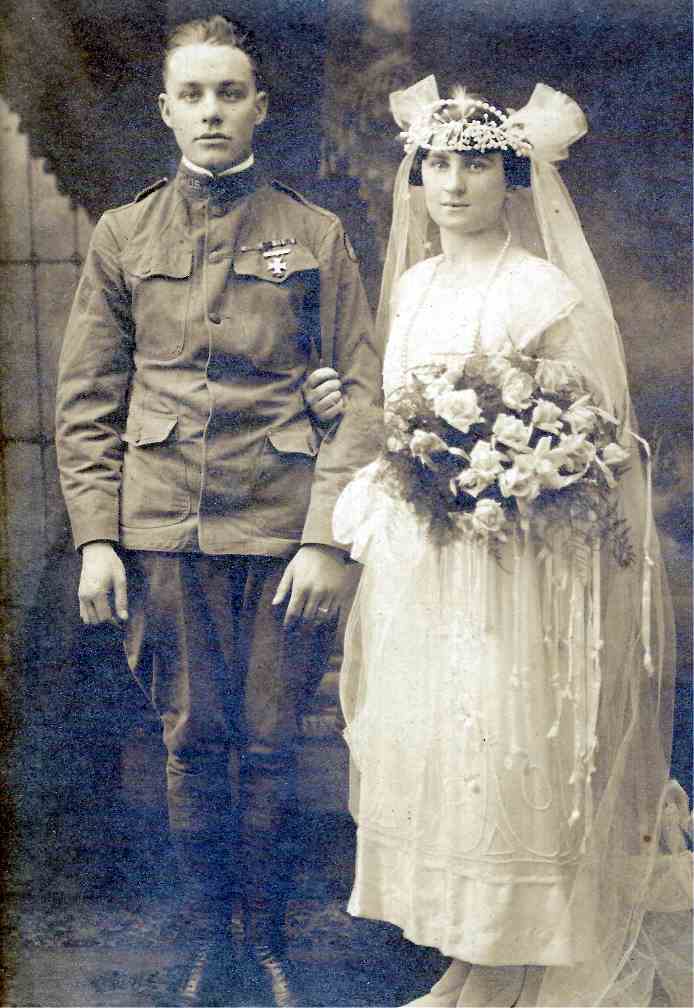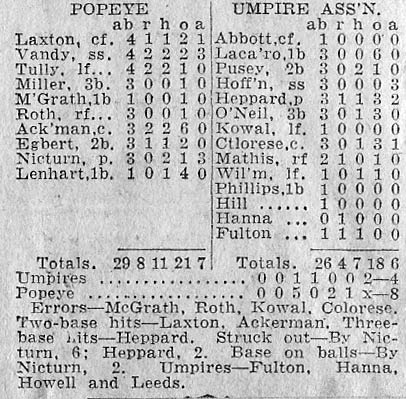|
George |

|
GEORGE S. NICKTERN was born December 8, 1897 to Mr. and Mrs. Edward Nicktern in New Jersey. At the time of the 1900 Census, which included his younger brother Ernest, lived at 757 Division Street. His father, Edward Nicktern, was a butcher. By 1910 Mrs. Nicktern had passed. Edward Nicktern and his sons George and earnest live at 221 Benson Street in South Camden. A younger brother, Harold, who was then six, had been placed at the Camden Home for Friendless Children. Harold Nicktern and his father would be reunited and were living together by 1919. George
Nicktern enlisted in the United States Army on January 27, 1913, and
served as a Bugler during World War I with Company M, 1st Pioneer
Infantry Regiment. The 1st Pioneer Infantry was formerly the 1st |
|
Once in France, The 1st Pioneer Infantry Regiment--a combat engineer unit--was assigned to the 79th Infantry Division's sector. In the first week of the Meuse-Argonne offensive, one company worked to keep a section of country road open, a narrow lane linking the village of Cuisy to the main, north-south, Malancourt-Montfaucon road. Under German artillery fire, these men struggled to clear away wreckage, fill in the shell holes and repair any damage that would obstruct passage of the troops. After the war, the company commander, Major (formerly Captain) Thomas H. Barber expanded his wartime diary and published his memories under the title, "Along the Road." It is an uncommon book, published in 1924, but the author provides graphic evidence of the transport and logistical difficulties experienced throughout the 1st Army area of advance. While seeking rations for his isolated commander, Barber recorded the following incident on the afternoon of October 1, 1918: I began to worry about food again. I had brought back about a day's supply. The mechanics had brought in about one meal, so I only had enough for a lunch and a light supper. The front was very quiet, no shelling; and the [Cuisy] road was in good shape. Things were getting dull. The wagons were not likely to arrive until the next day or the day after. I suddenly remembered that two days before, the Lieutenant who had moved the company forward, had reported that he could not get all the supplies and kitchen equipment on the ration cart, and had left them under a guard of one man. This guard had been completely forgotten! At least I could get half a day's rations there. By this time it had gotten cloudy; a thick fog had come up, practically preventing any direct artillery practice, and it was damp and cold. I decided it was safe enough to leave the company and that I would amuse myself by going back, see battalion headquarters, give directions about wagons and find out what I could about them. My own piece of road was open and traffic running fast and smoothly. When I got to the Malincourt [sic]-Montfaucon road, which was the main front-to-rear road, things were very different. It was jammed with ammunition and food trucks going up, and similar trucks filled with wounded going down, all practically at a dead standstill. One driver assured me--I think accurately--that they were not making better speed than one hundred yards an hour and had not been for twenty-four hours. They were still about four miles from Esnes where traffic congestion was relieved. The wounded were in a deplorable condition; half starved and burning with fever. They had practically no water, only what the drivers could scoop out of the roadside ditches. There was no straw in the trucks, practically no springs, and few blankets or coats for covering. They were bumped along at this incredibly slow pace hour after hour, with no hope of proximate relief. Some of them were screaming, obviously out of their head with fever, and there was a good deal of groaning and yelling. Most of them, however, were behaving pretty well. As I walked along the road it began to rain. I had gone about a mile when a very wan head looked over the edge of a truck and said, - "Captain, we are in awful trouble here; will you help us?" I said, - "I will if I can --what's the matter?" "Oh, there's a man in here that has been dead two days and he is taking up a lot of room and is getting pretty disagreeable. Will you help us get him out?" He was getting 'very disagreeable' all right; I could tell that from where I was, so I said, "Sure, I will," and stood up on the wheel. The whole floor of the camion seemed to be about two feet deep with wounded men, - a few 'sitting cases' round the edges and the rest all tangled up together as if they had been thrown in over the side, some of them were unconscious, most of them were semi-conscious. They were covered in spots by filthy blankets and overcoats; in the middle of them was a corpse with his mouth open and turning green. His arms were outstretched, his legs wide apart; he was all tangled up with the living wounded, and stiff as a three-inch plank! Dead and living all stunk. I about blew my breakfast, but managed to say, - "For the love of Mike, what did they put a stiff in with you for?" "They didn't—he died since we started." "How long ago?" "Day before yesterday." I whistled. I had an awful time getting into the truck without stepping on any one, but finally shuffled my feet down to the floor and got a stance; spent two full minutes getting parts of the corpse from under the living wounded and generally untangled. Then I tried to lift him, and couldn't. Stiffened in that position, he was about as unwieldy as a grand piano and I durst not run the risk of staggering and moving my feet. I yelled to a passing solder, - "Hey son! Get over the tailboard and help me throw out this stiff!." He climbed up, recoiled for a minute, got in carefully, took one end of him and I the other. We swung him a couple of times and slung him way over the side of the cart and off the road. He hit the bank (the road ran on a fill) and turned a cartwheel without bending; so stiff he was. We got out and went our ways under a shower of thanks from the wounded. During this offensive, on October 12, 1918 Private Samuel Wilbraham, a member of the 1st Pioneer Infantry Regiment who had lived near Merchantville and who had also served in the Army prior to America' entry into World War I, was reported missing in action. His body was not recovered. Shortly after returning home to Camden, George Nicktern had married victoria kwiatkowski. the couple lived at 1152 Penn Street when the census was taken in January of 1920. He was then working at a leather factory. George and Victoria Nicktern would remain at the Penn Street address through at least April of 1930. By then there were two daughters, Elizabeth and Edna. Victoria Nicktern's brother, Frank Kwiatkowski, resided with the family as well. George Nicktern joined the Camden Police Department on September 1, 1925. By 1947 he and his wife Victoria were living at 20 Leonard Avenue in East Camden. The Nickterns were active with the Mathews-Purnell Post of the Veterans of Foreign Wars, whose post home was at 2712 Hayes Avenue in Cramer Hill. In 1951 Victoria Nicktern served as president of the post's Ladies Auxiliary. George S. Nicktern passed away on March 9, 1952 and was buried at Beverly National Cemetery in Beverly NJ three days later. His wife Victoria Nicktern remained at the home on Leonard Avenue until 1972. Her last days were spent with her daughter in Pine Beach NJ. Victoria Nicktern passed away on December 17, 1995. |
|
|
This Photo of Victoria Kwiatkowski Nicktern is dated 1915. Wording on the back mentions Liberty Bonds, which were first authorized in April of 1917.

|
George & Victoria Nicktern
|
|
Camden Courier-Post - September 13, 1926 |
|
|
More than 1,2OO persons witnesses the second
annual track and field day of the
Camden police and firemen.
Ed
Menzies, a fireman is seen winning the 100 yard dash. Menzies
is second from the left. At his left is Clarence Phifer a policeman, who finished second, while at
menzies' right is George
Nicktern, another cop, who took third place.
The inset shows Barney Berlinger, Mercerburg Academy star, who, competing for
Meadowbrook, triumphed in the pole vault.
|
|
Camden 1930s |
|
Pitching Ace GEORGE NICKTERN |
Burly right handed flinger who hurled Wayne to the first half season championship of the Greater Camden League and who has heaved them to third place in the last half race. He has borne the brunt of the pitching burden for the entire season and deserves a world of praise for his efforts.
|
Camden Courier-Post - 1930s |
|
City League
Champs of the American Division
|
Here is Manager Bill "Fergie" McGrath's Popeye club, champions of the American Division in the Rhone Twilight League. This group of tossers yesterday annexed the crown by defeating the East End A. A. in a playoff match at the Civic Center diamond, 5 to 2. Shown in the above photo, front row, left to right, are: Chris Miller, T. Egbert, "Min" Fingers, W. Danley and Ott Laxton. Back row, left to right, are: Manager Bill "Fergie" McGrath, George Nicktern, Jim VanderStratten, Vince Conley, Harold Roth, Charley Lenhart, "Red" McGrath, Joe Tully and W. Crim, club official.
|
Camden Courier-Post - sometime between 1929 and 1935 |
||
|
||
of the Board of Education and also prexy of the Rhone Twilight circuit, officiated and pinch hit for the same outfit, getting a single in his lone trip to the plate, while Hanna walked and also scored.
Pat Heppard worked on the hill for the "umps" and was touched for 11 hits. The winners bunching these m the third inning when they scored five runs. Nicturn twirled for Popeye and gave up seven blows, two or which were made by Leo Pusey, while Vandy [VanderStraaten], Tully, Ackerman and Nicktern each collected a brace of blows for the winners.

|
Camden Courier-Post - March 21, 1928 |
|
|
|
COP IS ELECTED HEAD OF EAST CAMDEN ACES |
The East Camden Aces, a baseball club, reorganized last night by electing the following officers: George S. Nicktern, president; Ollie Guthrie, vice-president; Robert Ingham, treasurer; Frank Redshaw, financial secretary, and Ray Dilks, secretary.
Plans for organizing a baseball club will be made at a meeting to be held Monday night at the home of Robert Ingham, 120 Marlkton Avenue. The club has secured the services if "Dutch" Chris Miller, formerly of Reliance, and W. Cahill and Albreght of Pyne Poynt, and is ready to book games with all first class teams in South and North jersey.
Edward Keen has been selected to captain the team. all teams wishing games can arrange them by contacting George S. Nicktern at the First District station, Fifth and arch Streets.
|
Camden Courier-Post - 1928 |
|||
|
|
Camden Courier-Post - June 8, 1933 |
|
2 MEN SENT TO JAIL ON DISORDERLY CHARGES |
Two men arrested on charges of being drunk and disorderly were sent to jail yesterday by Police Judge Garfield Pancoast.
Frank Waite, 35, of 916 Pearl Street, was arrested at Eighth and Pearl Streets Tuesday night by Patrolman George Nicktern, after Nicktern said he asked Waite to leave the neighborhood because of a woman living in the vicinity being critically ill. Waite was given a 30-day sentence.
Ralph Foller, 33, of Oakland, California, was arrested at Fifth and Arch streets last night by Patrolman Joseph Dennett, and was given 10 days in jail.
|
Camden Courier-Post - February 2, 1938 |
|
INQUEST
SET TODAY IN GAMBLING DEATH Jury List Prepared for Coroner's Action in Holdup Fatality |
The coroner's inquest to decide the cause of death to Angelos Magalas, Greek chef, who was shot during a card game holdup at 725 Penn Street on January 11, will be held today at 10 a. m.
Coroner Franklin P. Jackson III, of Collingswood, will conduct the inquest and will select his jury of 12 from a list of 15 persons prepared by the office of County Prosecutor Samuel P. Orlando.
Detectives already have subpoenaed 20 witnesses for questioning at the inquest, including players who were the victims in the holdup and three Camden physicians who attended Magalas prior to his death.
The witnesses will include Samuel and Mabel Ermilios, tenants of the Penn Street house where the holdup occurred; George and Annette Mastros, who room at the house; Samuel Bosco, broadway barber; George Summers, Ross Pantel, Michael D' Andrea. and William Caras, who according to police were participants in the card game.
All of the men were held as material witnesses in the shooting when arraigned today before Police Judge Gene R. Mariano.
Doctors to Testify
Other witnesses will include Dr. Paul Mecray, Dr. A. S. Ross and Dr. Edwin R. Ristine and Miss Sophia MacAfee, a Cooper Hospital nurse. Police who will testify in elude Detectives Thomas Murphy, harry kyler and William Boettcher and Patrolmen Richard Powers, Frank Clements, George Nicktern and Sergeant Jack Deith.
The jury will be selected from Guy Clokey, Collingswood; Lawrence Ball, Haddonfield; Howard Friant, Collingswood; Harry Chew, Collingswood; Sig Schoenagle, Camden merchant; Raymond Hanly, real estate broker; Benjamin Brest, Raymond Worrel, John Eby, all of Camden; William H. Lorigan, Merchantville; David B. Robinson, Collingswood; Rev. James Pemberton and John McGowan, of Camden, Earl Jackson, of Collingswood and Morris B. Clark, of Haddonfield.
Coroner Jackson refused to give a certificate of death until the chemical test of Magalas' brain was made by Philadelphia experts. The re suit will not be revealed until the inquest.
Assistant Prosecutor Isaac Eason and County Physician David S. Rhone gave it as their opinion that Malagas died of natural causes rather than, the bullet wound. Coroner Jackson then ordered an inquest to be held.
Police are searching for Frank Luggi, 21, of 322 Penn Street, who they say was one of the holdup bandits and the one who fired the bullet that struck Magalas.
The last coroner's inquest held in Camden county was in 1933, in the death of Thomas Timothy Sullivan, and previous to that none had been held here in 25 years.
Sullivan was 57 years old and lived at 401 State Street. He was employed as a detective by the Pennsylvania Railroad. He was found shot to death in a shack in the rail road yards on August 28, 1933.
At that time, County Physician Edward B. Rogers issued a certificate of death that Sullivan had committed suicide. The decision of the county physician enraged members of Sullivan's family and they demanded an inquest.
The inquest was ordered by then Coroner Arthur H. Holl, who presided. All the evidence in the case was presented to the jury of 12 men, and after deliberating for less than an hour, they returned a verdict that Sullivan had been murdered by persons unknown.
Under state law, the county physician may order an inquest; with 12 persons on the jury of the coroner's choosing. The jurymen may be taken from the present panel of the petit jury or be picked at ran dom. The Grand Jury does not have to indict on the basis of the inquest. At the inquest Coroner Jackson will be assisted by attaches of the prosecutor's office.
Malagas, the father of three children, lived at 1110 Langham Avenue. He was shot when several armed bandits held up a card game and he died several days later.
|
Thanks to Mike Daly for his help in creating this page |